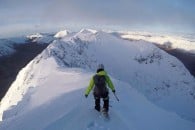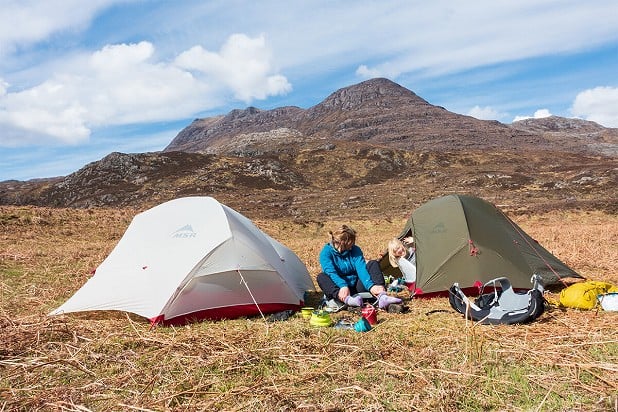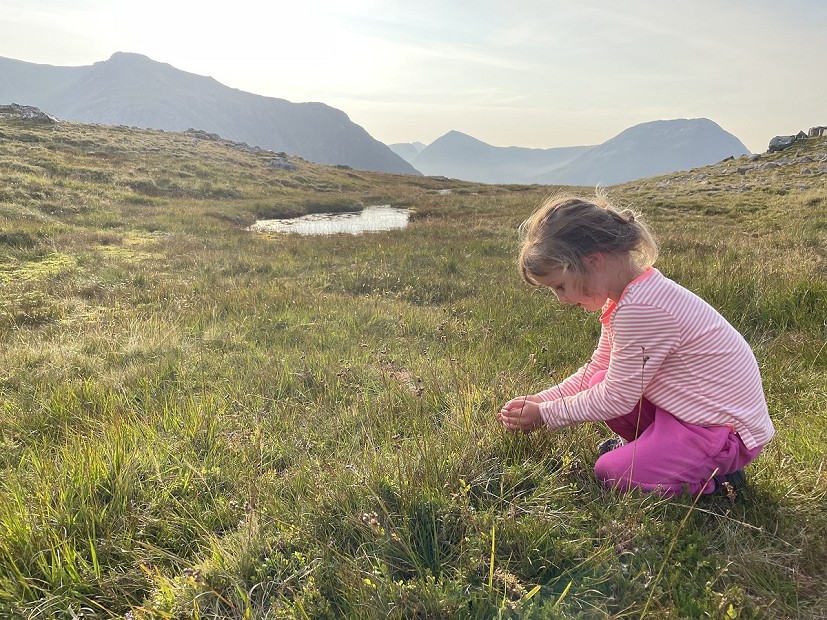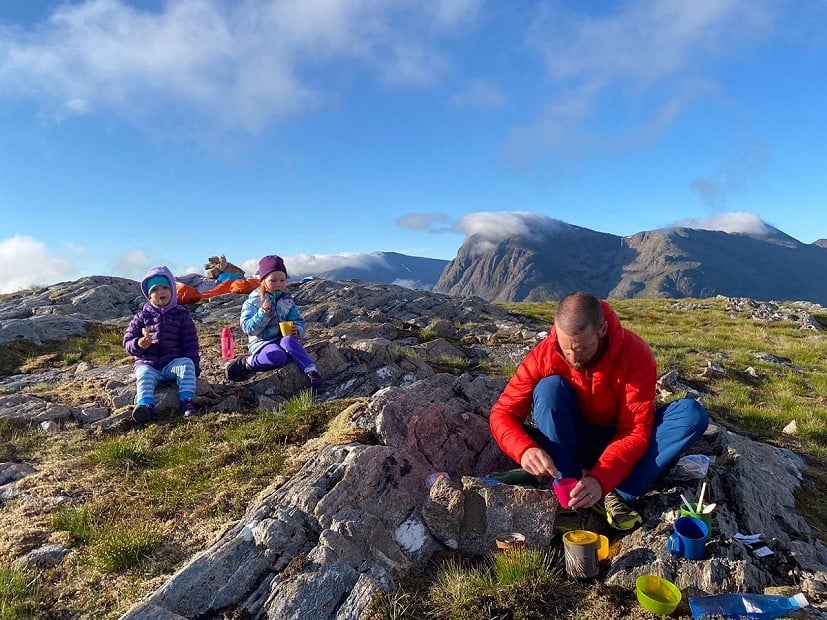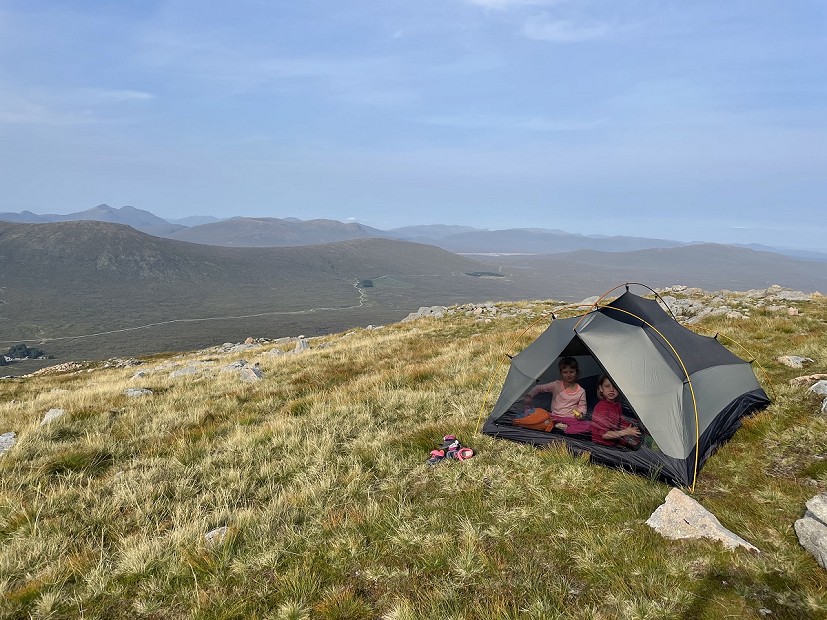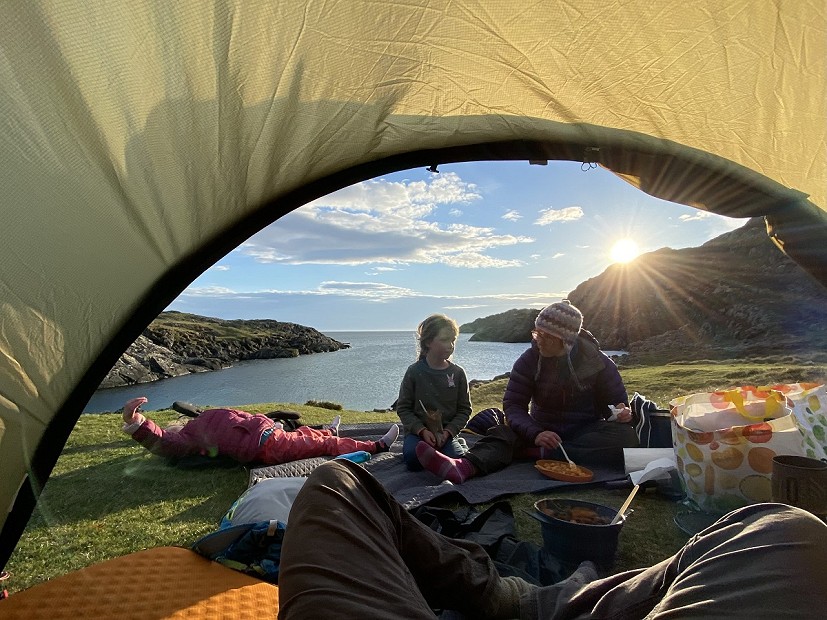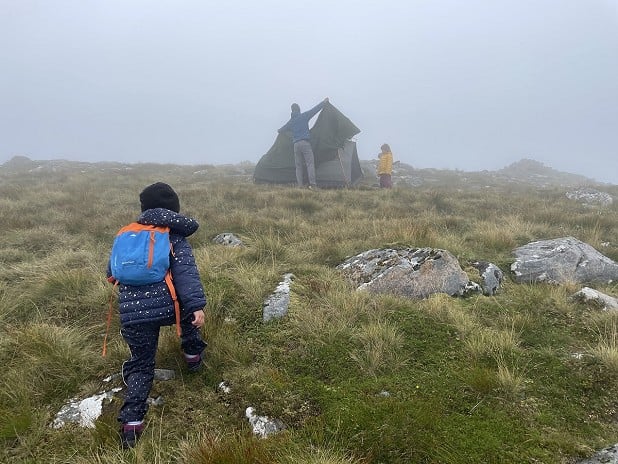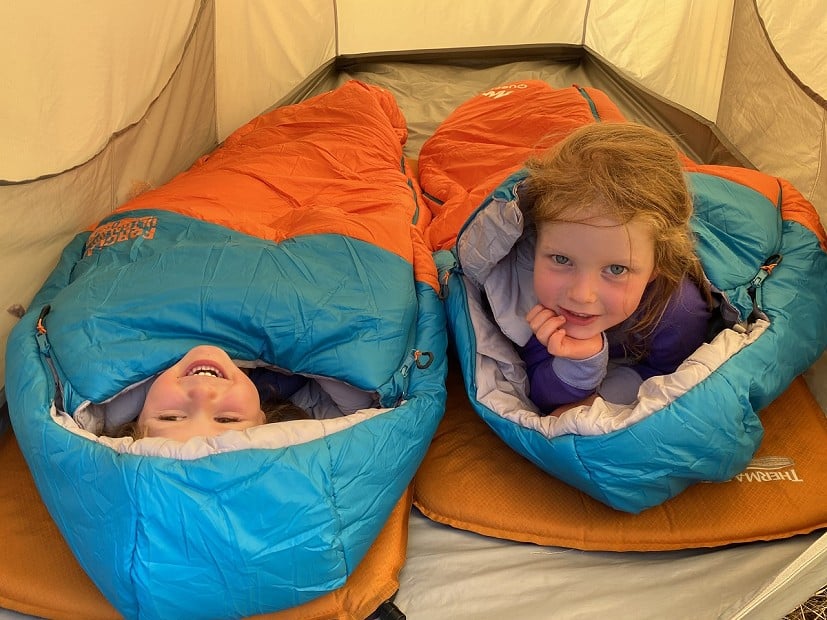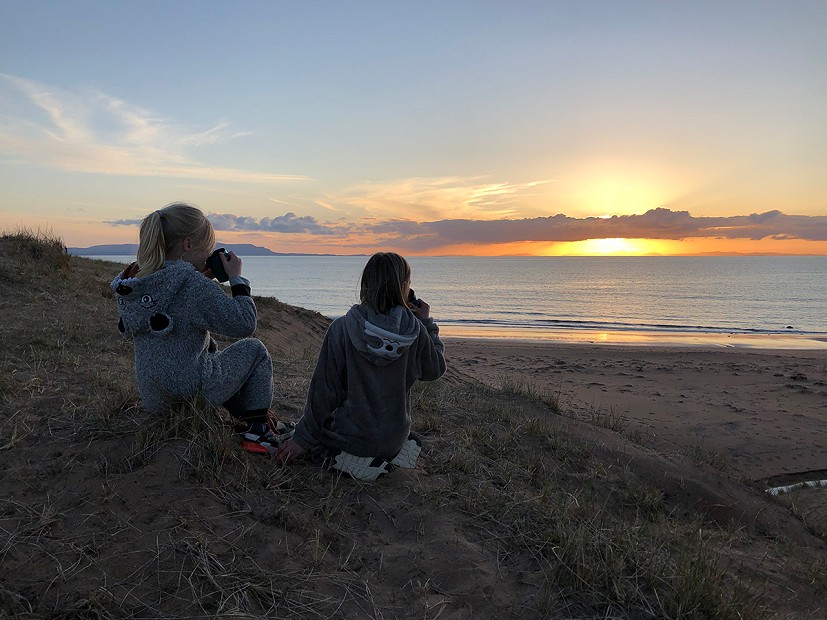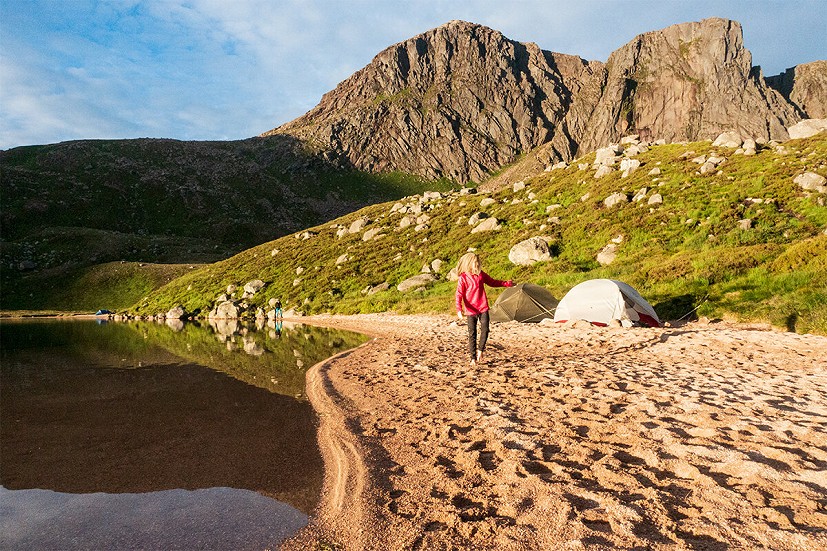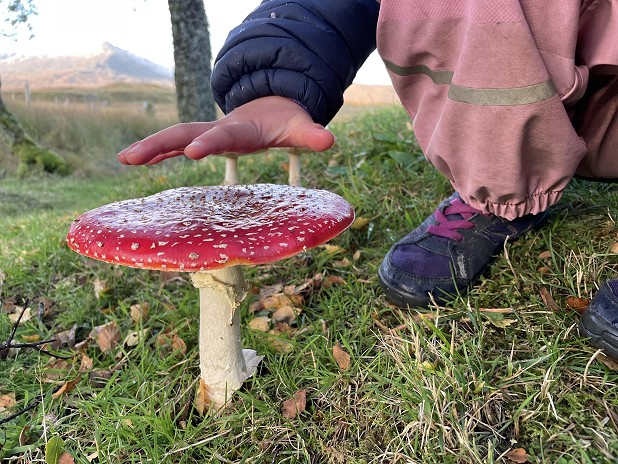Top Tips: Camping With Kids
Wild camping is one of the most enjoyable things you can do in the hills. A wholesome, immersive experience, it enables you to get up close and personal with the places that you love, without - let's hope - impacting them in the process. Introducing kids to these rewards is a pleasure in itself, and should hopefully lay the ground for their own passion for the hills. But combine tents, weather, midges and small people, and it's not always plain sailing. Here are some lessons I've learned over the last few years of family camping adventures.
Don't expect to sleep much
At first glance, taking the kids camping with no facilities may seem like a foolhardy idea. For younger children in particular, the bedtime routine is sacred, and sleep should be maximised at all costs - for kids and parents alike. Children are also fussy (well mine are): They need a certain nightlight, a particular degree of door open/closed, the right cuddly toy and definitely minimal excitement, if sleep is going to happen. Camping up a hill flies in the face of all this and it's fair to say that everyone involved will feel utterly wrecked the next day. But if you can get past the hassle and the sleep deprivation then you're onto a winner.
Don't skimp on essentials like teddies, or treats and snacks
Let them go wild
I find wild camping with my kids to be really liberating. I've enjoyed getting back to doing something that vaguely resembles life pre-parenthood, and it's such a joy to share the experience with them – waking up together in our own peaceful campsite, away from TV, tablets and wifi. We don't have to worry about them disturbing anyone or waking up too early and being noisy, as you might in a commercial campsite.
They can run about without restriction (in a safe spot, obviously). When they are surrounded by nature in this way, our girls find their own inventive games to play and become more absorbed in their environment. It's also a great opportunity to teach them basic campcraft and pitch the tent together. When we pack-down we always ask them to check all around for any visible signs that we've been there and make sure that we 'leave no trace'.
It's not easy; it's not lightweight
Camping is a bit of a dark art and it can take years to perfect a setup that works for you. So it will be no surprise to hear that doing it with kids is hard work.
Adult backpackers can obsess about saving weight, but for family trips with smaller people you may need to modify these expectations. The major problem is that you will need to carry A LOT of stuff. Even if your children are able to contribute to the portering, you will likely still have to shoulder the major burden. You'll need multiple grownups or a really big pack and ninja packing skills. Even with a super heavy bag, I wouldn't recommend skimping on the precious things like the essential teddy or favourite toy dinosaur, as you will probably regret it later and find yourself walking back to the car to get it.
Pitching up
First and foremost, make your job as easy as possible. In Scotland this is easy thanks to our liberated access regime; elsewhere you will need to be more circumspect. To wild camp in line with responsible guidelines, you may not have to climb a mountain or walk for hours into the most remote spot possible.
To minimise the cumulative impact try to choose an obscure spot away from popular honeypots, but make sure it's still relatively accessible, to keep the heavily-laden hiking to a minimum. If your kids are very young it's probably sensible not to get too committed, and then if nobody is having fun or you experience an injury/incident, you can dash back out quickly if you need to. You may find that once loaded up with a huge pack, even you won't be able to walk very far!
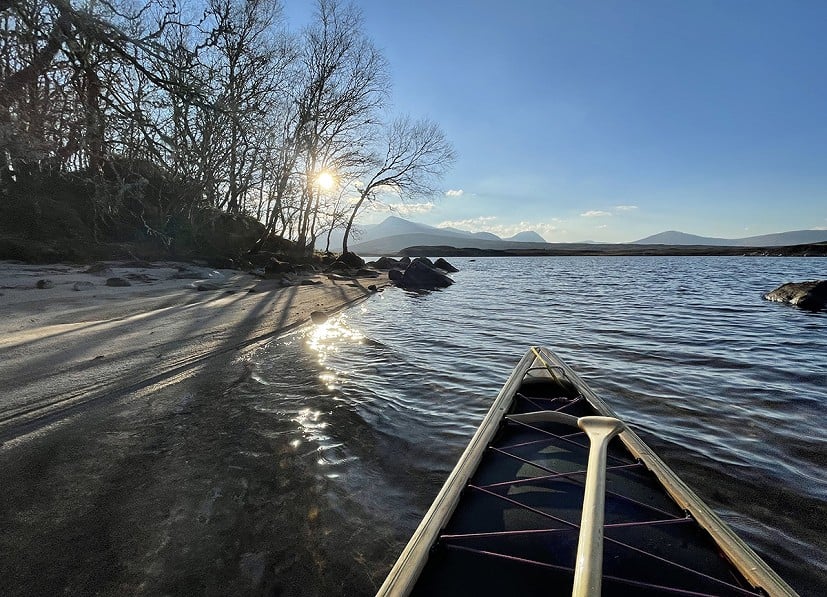
On the flip side, it is always worth getting away from the road/track as much as little legs will allow, because popular sites (usually those close to good access points) can get busy or dirty. However low-impact you are, you'll be contributing to the crowding, and any mess or anti social behaviour from others will detract from your overall experience. Be creative and come up with something more original – in most hill areas there is no shortage of good options out there.
On top of all the usual best pitch advice, find somewhere kiddie-friendly: this means staying well away from steep drops, big rivers or crags. You may be busy at camp and it's nice to know that the kids can roam about a bit without you having to watch their every move because of nearby hazards. Note that if visibility is poor/changeable, then you're not going to want to let them wander too far.
If you want to camp up high, consider walking in from the highest start point possible. An off-road buggy or bike trailer can be a handy way to transport lots of kit in via a long approach track, though clearly has limits when you venture off the gravel. Alternatively, if you're a paddler, then a short canoe trip can get you off the beaten track very quickly, and with minimal carrying. As long as you are not visible from the road or track and are pitched somewhere legally permissible, then you're good to go.
Respect the environment - and make sure the kids do too
Before covid, wild camping seemed something of a niche activity, reserved for avid hillwalkers and backpackers, or perhaps the occasional climbing trip to a remote mountain crag. But with a halt on international travel and closure of campsite facilities, the period following the end of lockdown 2020 saw a surge in popularity, as people flocked to the UK's beauty spots to exercise their much-missed freedoms. This has brought many problems, from fire lighting and littering to unsanitary toileting.
This well-publicised flurry of irresponsible behaviour may have somewhat marred the reputation of wild camping, and resulted in a rebound increase in environmental campaigns aimed at clearing and monitoring popular sites, as well as educating the general public on how to camp responsibly. I like to think that we are now on the road to recovery but with our upland areas and surrounding campsites still busier than ever before, it seems the increased interest in wild camping is here to stay. Prevention is not only about educating those adults who are new to the hills, but also our young people, the next generation of hill-goers, in how to best respect, protect and enjoy our upland landscapes.
Here are some tips based on my experience:
Tent
We can all do our bit by encouraging our children to love and respect nature
Taking a lightweight tent a must. But often lightweight tents are expensive, less robust and have a relatively small sleeping area per person, so there is a clear trade-off. Beware: young children will be a liability around fragile zips and will trip over guylines every eight seconds. A tent with a good-sized porch/vestibule helps for storing kit, sheltering kids or changing clothes and shoes, which can be messy and faffy inside your precious tent interior.
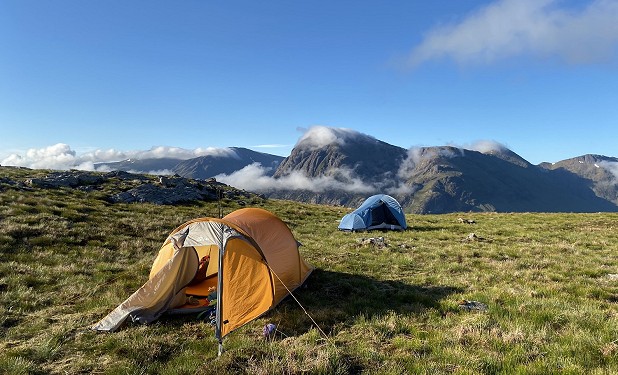
Sleeping kit
Make sure you get something light and packable but plenty warm enough (less complaining is always the goal). The temptation is to use lightweight down sleeping bags but note that if you have young children who still sometimes wet the bed, it's preferable to go synthetic! Test out the sleeping bag at home to check that they can sleep well despite its restrictive nature (my eldest continuously fights and squirms inside hers and now has a camping 'quilt' instead). Go for lightweight sleeping mats too - you could cut down a roll-mat or buy a sleeping mat that isn't full length. If your children sleep with a blackout blind at home, they might appreciate an eye mask or Buff to pull down.
Cooking
Consider using a stable tripod-style stove rather than something precarious and easy to knock over. You're going to need a biggish pan for cooking a group meal, or perhaps you'll prefer to save space and weight with dehydrated meals. Whatever you go for, make sure you know they will take to the food, as most kids are a bit fussy. Any parent knows that hungry children are a nightmare and it will be difficult for them to enjoy camp (let alone walk back out again) if energy levels are low. It's worth bringing a few treats, from sweets to hot chocolate, which can be worth their weight in gold if morale is dipping.
Water
As with any wild camp, make sure to pitch close to a good water source. Otherwise you are going to be lugging a lot of water in your pack, which will already be very heavy. Take a flat-pack water carrier to reduce refilling trips, and ideally boil or filter your water before use (most kids will find drinking water tainted with purification tablets distasteful and they will have less robust tummies than adults).
Weather
Any camping is more fun in good weather. Adults may perversely enjoy a bit of a sufferfest, with the tent-flapping all night, but most kids won't thank you for that kind of introduction. If you're going to be camping high and remote, or walking a relatively long way, then make sure you go big on layers and have full waterproof body cover for the children. When you're carrying so much more than usual, it can be tempting to skimp some of the basic things, but this risks getting caught out. Make sure the children are up to the job and capable of moving on the terrain before getting too ambitious. Build their hill confidence on day walks before you consider a remote camping night.
Midges
Frankly, camping with kids when it's really midgey is a bit of a shocker. Reduce the problem by picking somewhere that will catch a breeze, and be double sure to bring plenty of midge nets and repellent. Being slick at tent set-up is also key. If you have a stand-alone inner mesh, that can be a good place to stash the kids while you get everything else prepared. In summer it may be best to avoid a still forecast altogether, unless it's very dry and sunny.
First aid
Carry a first-aid kit adapted for childhood ailments. This usually entails all the usual things, plus extra plasters and age-appropriate pain relief such as Calpol/Nurofen. You may consider something for bites and stings. Bring with you any prescription medicine they might need.
Toileting
Go a long way from any water sources, and properly bury all waste. Carry a trowel for this job(by), plus enough nappy/poo bags to safely store everyone's used toilet paper, and take it all out with you as you would for all your other litter. Ideally source some compostable bags for this - and do double-bag it! Toileting in the outdoors is a great opportunity to teach your children about biodegradable and non-biodegradable waste and the importance of leaving a clean camp site for future walkers and campers.
Leave no trace
This concept is about more than just packing out your waste, litter and equipment, it's also about leaving your site visually as undamaged and undisturbed as when you arrived. Kids love to turn over rocks, catch bugs and climb trees and it can be a tricky balance to let them discover and enjoy nature without disturbing wildlife or damaging vegetation and micro-habitats along the way. We can all do our bit by encouraging our children to love and respect nature and find that balance for themselves.
Added interest
Kids might not appreciate the walk-in, the lovely view or the fresh air in the same way you do. You can add child-friendly activities such as foraging, scavenger hunts, wild-dipping or bouldering to mix things up a bit.
Going Solo
It's definitely a struggle to go wild camping as a solo parent, but with some effort and motivation it can be done. Last summer, I walked through the Chalamain Gap in the Cairngorms with my two girls and camped on Creag a' Chalamain (a short walk to a 787m hill, from a high start). Although the objective was very manageable for us, my bag was enormous and our food was very practical (read 'a bit grim'). We didn't get much sleep but we had loads of fun playing and exploring late into the evening, as it was so warm and sunny. I think it will be the first of many such sole-parent trips.
My top tip from that excursion is NEVER play hide-and-seek with 'little bunny' (rock-coloured rabbit) high on the Cairngorm's sub-arctic tundra*
*Little Bunny was discovered safe and sound after a few hours of searching. Thankfully Mountain Rescue were not required to locate the missing party.
